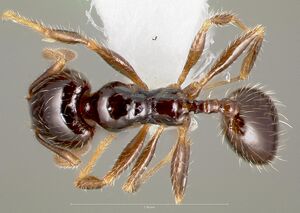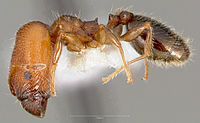Pheidole clementensis
| Pheidole clementensis | |
|---|---|

| |
| Scientific classification | |
| Kingdom: | Animalia |
| Phylum: | Arthropoda |
| Class: | Insecta |
| Order: | Hymenoptera |
| Family: | Formicidae |
| Subfamily: | Myrmicinae |
| Tribe: | Attini |
| Genus: | Pheidole |
| Species: | P. clementensis |
| Binomial name | |
| Pheidole clementensis Gregg, 1969 | |
Roy Snelling (in Gregg 1969) reports that P. clementensis is one of the commonest ants on San Clemente Island (especially on the seaward side), where it nests under stones. The minor workers are nocturnal, starting to forage shortly before sundown. They are evidently mostly or entirely granivorous, preferring the seeds of Cassus cretica but also gathering grass seeds and those of a small legume, probably a species of Lotus. The majors form an unusually high percentage of the worker population. (Wilson 2003)
Identification
The Pheidole californica complex comprises three closely related and partly sympatric species of seed harvesting ants restricted to the western Nearctic region. Pheidole clementensis Gregg may be distinguished from both Pheidole californica Mayr and Pheidole creightoni Gregg by the diagonal rather than longitudinal rugulae between the clypeus and the eye in lateral View. The closely related P. californica and P. creightoni are most readily distinguished from one another by the angle of their lateral cephalic setae. Pheidole californica has decumbent setae forming an angle of forty-five degrees or less with the lateral margins of the head in full face view, while the cephalic setae of P. creightoni emerge at an angle of approximately ninety degrees. (Burge, 2005.)
See also the description in the nomenclature section.
Keys including this Species
Distribution
Pheidole clementensis is limited to foothill and coastal habitats of southern California and northern Baja California (Burge, 2005). San Clemente Island and parts of mainland California (Philip S. Ward, personal communication, in Wilson, 2003).
Latitudinal Distribution Pattern
Latitudinal Range: 33.638633° to 28.85138889°.
| North Temperate |
North Subtropical |
Tropical | South Subtropical |
South Temperate |
- Source: AntMaps
Distribution based on Regional Taxon Lists
Nearctic Region: United States (type locality).
Neotropical Region: Mexico.
Distribution based on AntMaps
Distribution based on AntWeb specimens
Check data from AntWeb
Countries Occupied
| Number of countries occupied by this species based on AntWiki Regional Taxon Lists. In general, fewer countries occupied indicates a narrower range, while more countries indicates a more widespread species. |

|
Estimated Abundance
| Relative abundance based on number of AntMaps records per species (this species within the purple bar). Fewer records (to the left) indicates a less abundant/encountered species while more records (to the right) indicates more abundant/encountered species. |

|
Biology
Association with Other Organisms
 Explore: Show all Associate data or Search these data. See also a list of all data tables or learn how data is managed.
Explore: Show all Associate data or Search these data. See also a list of all data tables or learn how data is managed.
- This species is a host for the eucharitid wasp Orasema sp. b2 nr bakeri (a parasitoid) (Quevillon, 2018) (encounter mode independent; direct transmission; transmission outside nest).
Castes
Worker
Minor
Images from AntWeb
   
| |
| Worker. Specimen code casent0005756. Photographer April Nobile, uploaded by California Academy of Sciences. | Owned by UCDC, Davis, CA, USA. |
Nomenclature
The following information is derived from Barry Bolton's Online Catalogue of the Ants of the World.
- clementensis. Pheidole clementensis Gregg, 1969: 93, fig. 1 (s.w.) U.S.A. See also: Wilson, 2003: 572.
Unless otherwise noted the text for the remainder of this section is reported from the publication that includes the original description.
Description
From Wilson (2003): DIAGNOSIS A member of the “pilifera complex” of the larger pilifera group; for a characterization of the complex, see under Pheidole pilifera. P. clementensis is distinguished within the complex by the following combination of traits.
Major: side of head densely rugoreticulate; occiput extensively rugulose; pronotum smooth and shiny, propodeal spine moderately large, acute; postpetiole from above trapezoidal; humerus in dorsal-oblique view low and smooth and shiny.
Closest to Pheidole californica, from which it differs by its larger size (HW in clementensis about 1.1 mm, in californica major about 0.90 mm) and proportionately smaller eye (major EL/HW 0.13 in clementensis versus 0.20 in californica).
MEASUREMENTS (mm) Paratype major: HW 1.08, HL 1.18, SL 0.54, EL 0.14, PW 0.54. Paratype minor: HW 0.54, HL 0.56, SL 0.52, EL 0.12, PW 0.30.
COLOR Major: head dark yellow, with at least occasionally a pair of medium brown spots on vertex, falling on either side of the cephalic midline; rest of body light yellowish brown.
Minor: body concolorous dark brown, appendages yellow.
Figure. Upper: paratype, major. Lower: paratype, minor. Scale bars = 1 mm.
Type Material
CALIFORNIA: Pyramid Head, San Clemente Island,San Diego County. Los Angeles County Museum of Natural History, American Museum of Natural History and Museum of Comparative Zoology - as reported in Wilson (2003)
Etymology
Referring to the type locality. (Wilson 2003)
References
- Wilson, E. O. 2003. Pheidole in the New World: A dominant, hyperdiverse ant genus. Harvard University Press, Cambridge, MA.(page 572, fig. major, minor described)
- Alatorre-Bracamontes, C.E., Vásquez-Bolaños, M. 2010. Lista comentada de las hormigas (Hymenoptera: Formicidae) del norte de México. Dugesiana 17(1): 9-36.
- Burge, D.O. 2005. Taxonomy, biology, and distribution of seed harvesting ants in the Pheidole californica complex (Hymenoptera Formicidae). Journal of Hymenoptera Research 14, 137-150.
- Gregg, R. E. 1969b. New species of Pheidole from Pacific Coast islands (Hymenoptera: Formicidae). Entomol. News 80: 93-101 (page 93, fig. 1 soldier, worker described)
References based on Global Ant Biodiversity Informatics
- Backlin, Adam R., Sara L. Compton, Zsolt B. Kahancza and Robert N. Fisher. 2005. Baseline Biodiversity Survey for Santa Catalina Island. Catalina Island Conservancy. 1-45.
- Burge D. O. 2005. Taxonomy, biology, and distribution of seed harvesting ants in the Pheidole californica complex (Hymenoptera: Formicidae). Journal of Hymenoptera Research 14: 137-150
- Dattilo W. et al. 2019. MEXICO ANTS: incidence and abundance along the Nearctic-Neotropical interface. Ecology https://doi.org/10.1002/ecy.2944
- Gregg R. E. 1969. New species of Pheidole from Pacific Coast islands (Hymenoptera: Formicidae). Entomological News 80: 93-101.
- Johnson, R.A. and P.S. Ward. 2002. Biogeography and endemism of ants (Hymenoptera: Formicidae) in Baja California, Mexico: a first overview. Journal of Biogeography 29:10091026/
- Matsuda T., G. Turschak, C. Brehme, C. Rochester, M. Mitrovich, and R. Fisher. 2011. Effects of Large-Scale Wildfires on Ground Foraging Ants (Hymenoptera: Formicidae) in Southern California. Environmental Entomology 40(2): 204-216.
- Vásquez-Bolaños M. 2011. Lista de especies de hormigas (Hymenoptera: Formicidae) para México. Dugesiana 18: 95-133
- Wilson, E.O. 2003. Pheidole in the New World: A Dominant, Hyperdiverse Genus. Harvard University Press


